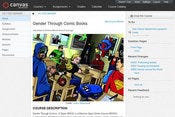Education Giant Pearson Adapts To Digital LearningEducation Giant Pearson Adapts To Digital Learning
Pearson, the world's largest educational publisher, recognized older students as online learning harbinger.


8 MOOCs Transforming Education
8 MOOCs Transforming Education(click image for larger view and for slideshow)
Schools aren't the only ones grappling with big questions about online learning, flipped classrooms, assessment analytics and open-source alternatives to commercial products. Traditional publishers are making changes, too.
Pearson, the world's largest education publisher, was early to embrace the digital future, according to observers. The company says more than half of its revenues last year came from digital products and service.
Pearson is composed of its global education group of Pearson International, Pearson North America, and Professional; the Financial Times Group, publisher of the Financial Times newspaper and other specialty editorial and research products; and the Penguin Group, an international consumer publisher. Penguin is being merged with Bertelsmann's Random House to create the world's biggest trade book publisher, Penguin Random House, under a joint venture.
[ Looking for free online classes? Read 12 Open Educational Resources: From Khan to MIT. ]
"We've organized internally around three A's -- achievement, access and affordability," Todd Hitchcock, senior VP of online solutions and business development at Pearson, told information in a phone interview.
The three A's reflect Pearson's predictions about the market, based on its own research over the last three or four years, he said. Among other things, Pearson saw a changing student profile, especially in higher education, where the average age is now 38.
"The demographic changing," Hitchcock said. "[They] need flexibility … so access becomes more online and blended." Similarly, although Hitchcock isn't sure that massive open online courses (MOOCs) will transform education, they have had the effect of "shining a light on online learning, access and affordability models," he said.
Then again, a technology itself can sometimes spark change.
Take Pearson's eText platform, a database of grade-specific educational content. eText was honored as information's "Best Emerging Technology: Enterprise Mobility" last September. eText is now being developed as an overall solution for students, Hitchcock said, adding, "It's an opportunity to rethink the whole ecosystem for the learning."
Pearson isn't alone in noting shifts in the education market. A 2012 Babson Survey of online learning revealed that over 6.7 million students were taking at least one online course during the 2011 fall term, an increase of 570,000 students over the previous year. Based on responses from over 2,800 academic leaders, the survey, "Changing Course: Ten Years of Tracking Online Education in the United States," also found that online learning was critical to the long-term strategies of 69% of chief academic leaders. From the outside, at least, the greatest competitive threat to traditional education publishers would seem to be open educational resources (OER). Noncommercial OER is to instructional content what open-source code is to software.
But OER is just another facet of new education tactics, insists Hitchcock. "What we're seeing is more convergence," he said. Schools and teachers want ways to "weave them into a solution." To this he adds that because Pearson offers services for "every single element, except instruction, open source doesn't frighten us."
In fact, Pearson and the other big education publishers didn't always have this inclusive philosophy about OER, when they thought it was a competitor, says a former Pearson executive and now digital education strategist and analyst. There was a time when "all the big players thought the best they could do was lock it out," said Frank Catalano, a founding columnist at GeekWire and a Pearson senior VP from 2004 to 2008. "But this is a customer-driven business," Catalano continued. "Customers said flat out, "'We want to use these materials.'"
Catalano believes Pearson's biggest competition comes from its two main rivals, McGraw-Hill Education and Houghton Mifflin Harcourt, which have narrowed Pearson's once-clear lead in digital products. "All of the big three have digital-savvy people at the helm now," Catalano said.
But Pearson senior executives tout their strengths. "We have more digital learners using Pearson products (over 11 million in 2012) than all of our content competitors combined," Jerome Grant, chief learning officer for Pearson Higher Education, said in an email interview. With the purchase of online program design and development, marketing and enrollment and technology company Embanet last fall, Grant said, "We are now able to truly partner with colleges and universities to provide content, technology, platform and services. We are the only learning company with these capabilities."
Hitchcock points out that helping schools keep pace with digital calls for a different approach to product development and deployment, one that is more dynamic and iterative. It also requires input from many groups, including student advisory boards. Building such "tight feedback loops" explains Pearson's recent outreach to constituents willing to share anonymized data, with the end goal of demonstrating the efficacy of teaching products and practices, Hitchcock said.
"Traditionally, a publisher sells a book," he says. "Now we're focused on the entire solution, helping the student be successful.
Education IT directors are leveraging technologies and technology models that allow them to implement the right products and services for schools right now. In this Top Tech Tools For Educators report, we'll look at some of the tools schools are using and how they're being put to work in the classroom to engage students and improve learning. (Free registration required.)
About the Author
You May Also Like






